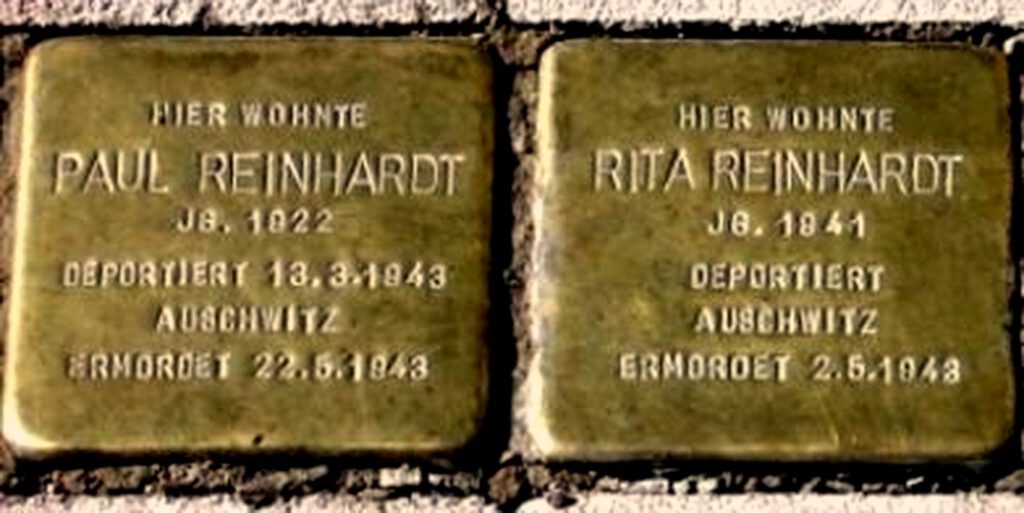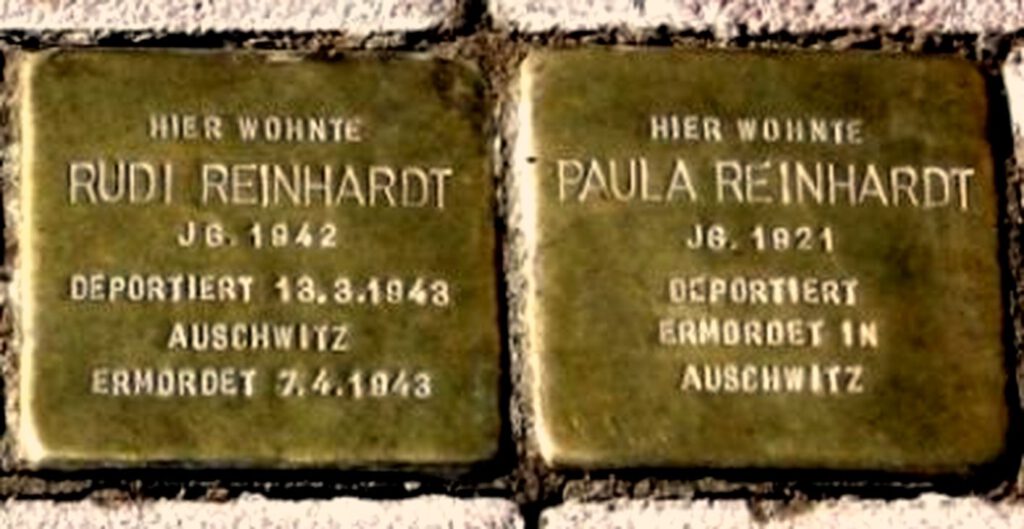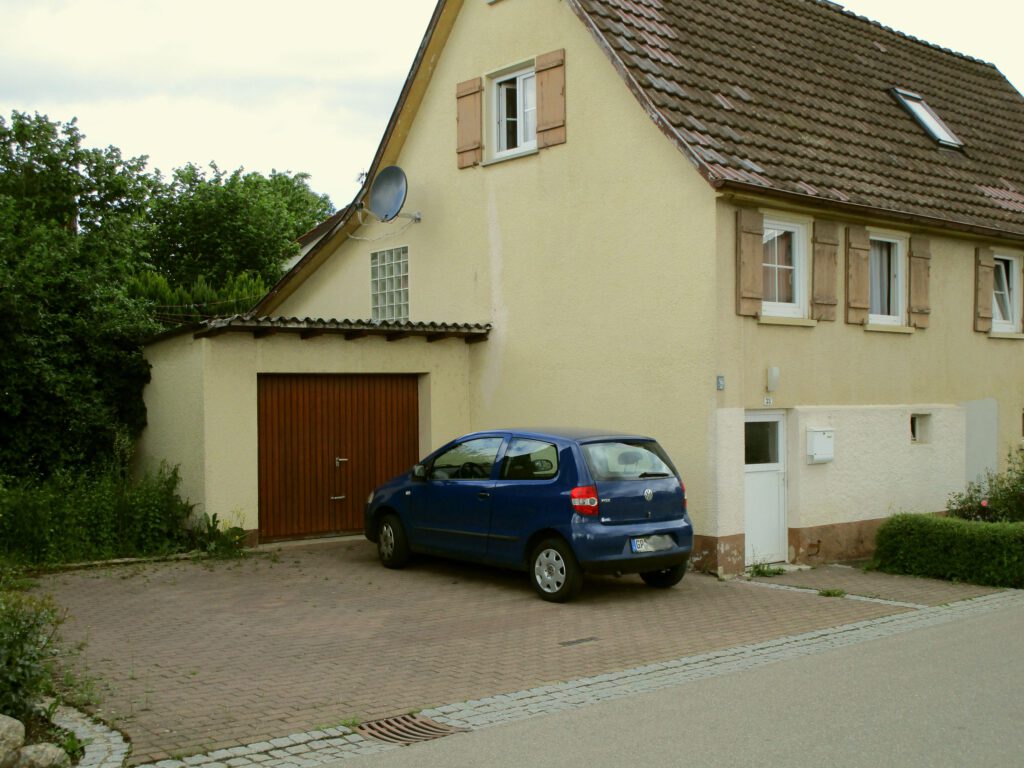Eschenbacher Straße 38-42


Three siblings move to Göppingen – Holzheim
Patrizka (Dudele) Reinhardt, born on 7 June 1925 in Stein am Kocher came from Heiningen to Holzheim / St. Gotthardt on 11 June 1942 at the age of seventeen. She lived and worked with a farmer’s family. Her stay here ended after only nine months. A letter from Feeß, the head of the village of Holzheim, to the Crailsheim labour office states that she “got away (by) measures of the Reich”. The documents of the Göppingen Residents’ Registration Office are clearer. There her “departure” to Auschwitz is recorded for 13 March. Patrizka Reinhardt was forcibly sterilised but survived the persecution under National Socialism. She married after the war and later lived in Garmisch-Partenkirchen.
Paula (actually: Paulina) Reinhardt, Patrizka’s older sister, was born on 21 April 1921 in Bühlerzell. She came to Holzheim on 4 March 1942 together with her little daughter Rita, born on 4 December 1941 in Augsburg, from where she first lived with Bassler at Staufenstraße 16. Paula was not married, Rita’s father, August Labmeier from Pleckenthal / Vilshofen was a soldier in the German Wehrmacht at that time. On 1 September 1942, Paula moved with Anna Reinhardt (see below) to what was then Eschenbacherstrasse 18 in St. Gotthardt. She had also changed jobs in the meantime, working as an unskilled worker in the veneer and plywood factory in Holzheim. Her daughter Rita was placed in a private foster home from April 1942, then in the St. Vinzentius children’s home in Donzdorf from 20 May 1942. The district youth welfare office paid for the girl’s upkeep. Had Anna voluntarily given her daughter into care?
Four weeks before the other Sinti from Holzheim were taken away by the criminal police, Paula Reinhardt moved to Lower Bavaria with her daughter Rita. On 5 March 1943 she then registered at the residents’ registration office in Lalling. But even there they did not escape their persecutors. The district youth welfare office in Göppingen received a letter on 26 May 1943 informing them that “the ward Rita Reinhardt, born on 4 December 1941, (had) died in the local camp on 2 May 1943”. The sender of the death notice was the Auschwitz concentration camp. Paula, who was registered with her daughter in the Auschwitz-Birkenau concentration camp on 10 April 1943, died there on the first of April 1944. It is not known how she was murdered.
Paul (Ziegeli) Reinhardt, born on 22 April 1922 in Laufen am Kocher was a brother of Paula and Patrizka Reinhardt. On 23 August 1941 he moved from Donzdorf to Holzheim. There he first lived and worked on the farm of the farmer Hauser at Hofstraße 5. Later he was employed at the Holzheim veneer and plywood factory and lived (not registered) with his sister Paula in St. Gotthardt.

was located in the place of the parking lot
Anna and Paul – the Forbidden Marriage
Anna Reinhardt, born on 30 January 1920 in Zuttlingen / Möckmühl, Paul Reinhardt’s girlfriend and fiancée, also lived here. (Coincidentally, Anna bore the same surname as her fiancé Paul). She had moved from Giengen an der Brenz to Holzheim on 27 October 1941, where she initially lived with the Moll family in Friedrichstraße. On 18 August 1942, their son Rudi was born in the Göppingen district hospital. Anna and Paul Reinhardt, Rudi’s father, wanted to marry in the same year.
But marriage among ‘Gypsies’ required special permission because the procreation of ‘inferior races’ was not desired for ideological reasons. Beforehand, those wishing to marry had to have a ‘racial biology certificate’ drawn up. For Paul Reinhardt, the report of the ‘Rassenhygienische Forschungsstelle’ (Research Centre for Racial Hygiene), drawn up on 24 June 1942, classified him as a ‘Gypsy mongrel’. The consequences this had for him and Anna Reinhardt are explained in a letter from the criminal investigation department in Stuttgart: “I ask … to raise objections against the marriage of the Reinhardts and to arrange for the further steps to be taken. A marriage between gypsy mongrels is only desired under the condition of voluntary sterilisation.”
Because they did not want to comply with this blackmailing demand, Anna and Paul refrained from marrying. However, this led to their non-marital togetherness being condemned by villagers as immoral. The village head Feeß wrote a letter to the mayor of Göppingen on 30 December 1942: “The two gypsy women are accommodated in the municipal residential house in St. Gotthardt. The bridegroom of a Reinhardt, Paul Reinhardt, is there as a subtenant. The cohabitation is and remains genuinely gypsy-like, causing a public nuisance in little St. Gotthardt. I request the responsible authorities to ensure that these gypsies are transplanted and separated at the same time. If this is not possible immediately, then at least Paul Reinhardt, who worked for a farmer for a long time, should be obliged to work for an external agricultural employer. This will then solve the housing question for Paul Reinhardt.”
In the Auschwitz – Birkenau concentration camp
Three months later his request was to be fulfilled, albeit in a different, much worse way. As long as Paul and Anna had lived in St. Gotthardt, they already had to report to the police once a week. The arrest followed in March 1943. After the war, Anna Reinhardt described the events of that time:
“They said we would be arrested provisionally and on Monday we came to Stuttgart. I was not questioned at all, and I don’t know why I was arrested. When I was arrested, all the Gypsies came with me, both my fiancé and his sister. I, my fiancé, and his sisters were the only ones who came from Göppingen to Stuttgart. From Stuttgart we were transported to Auschwitz in the evening. It was a whole railway train full of Gypsies.”
In the concentration camp, the new arrivals had a prisoner number burned into their arm, and the children were marked on their feet. Rudi Reinhardt, just seven months old at the time, did not survive the camp for long. Less than four weeks after his arrival, the commandant’s office of the Auschwitz concentration camp informed the Göppingen district youth welfare office of his death: “The Gypsy mongrel Rudi Reinhardt died in the local Gypsy camp on 7 April 1943.” As the daughters of Anna Reinhardt reported, he died of starvation: “She (Anna) only got a piece of bread, which she shared with the child. But that was not enough. … The child starved to death, it was very scrawny. When it was dead, she had to throw it on a cart. … The mothers were not even allowed to cry in public, otherwise they would have received 30 strokes on the bottom. They were not allowed to show any grief, otherwise they would still have been whipped.”
Paul Reinhardt also died in the Auschwitz concentration camp. He was shot on 22 May 1943 after trying to escape.
The prisoners’ lives were constantly threatened by death. Those who could no longer perform the mostly hard physical work were murdered or shot in the gas chambers. Anna Reinhardt once tried to escape from the camp with her brothers, whom she had met again in Auschwitz. The escape attempt failed and those discovered were already about to be shot when an air raid forced the SS to stop the execution.
In August 1944, the so-called Gypsy family camp in Auschwitz-Birkenau was dissolved. The prisoners who were considered fit for work by the camp management were transferred to other camps, and those who remained behind were gassed. The next station on Anna Reinhardt’s path of suffering was the Ravensbrück concentration camp, after which she worked under duress in the subcamps of Altenburg and Taucha, which belonged to the Buchenwald concentration camp. On 13 April 1945, she was liberated by Allied troops in the Altenburg camp. After the end of the war, Anna Reinhardt returned to Württemberg and found her mother near Heilbronn.
Between a quarter and half a million people fell victim to the extermination of the European Sinti and Roma planned and implemented by the National Socialists. Among them were Anna Reinhardt’s relatives and acquaintances: her fiancé Paul, her brothers Konrad and Josef, her son Rudi and the girl Rita, daughter of her sister-in-law Paula. As her daughters recounted, Anna Reinhardt was scarred for the rest of her life: “Her mother felt the concentration camp forever, health-wise and in general. In the beginning she had severe depression because she had lost so many family members … That took its toll on her.”
Anna Reinhardt met a man who had been involved in enforcing the discriminatory measures against the Holzheim Sinti again after the war. Her daughters told of one of these encounters: “Later, after the war, he once sat in the ‘Bock’, a local pub. There he had the landlady give his mother a beer. She then got up and emptied it into his face.”
Anna Hirsch, née Reinhardt, died on 1 May 1983 at the age of 63 in Sulzbach-Laufen, where she had lived until her death. After the war she had married Karl Hirsch and had eight children with him. When asked about her mother’s relationship with the inhabitants of Holzheim and St. Gotthardt, one of her daughters replied: “She always raved about Göppingen. I think she would have settled there if she hadn’t been deported.”
Since April 2007, the Stolpersteine for Paul and Rudi Reinhardt as well as for Paula and Rita Reinhardt have been placed on the spot where the Reinhardts’ home had stood.
This text is based on Matthias Storr’s contribution to the volume ‘Göppingen unterm Hakenkreuz’ page 224 ff. and on further research by the author.
(19.03.2017 kmr)















Leave a Reply